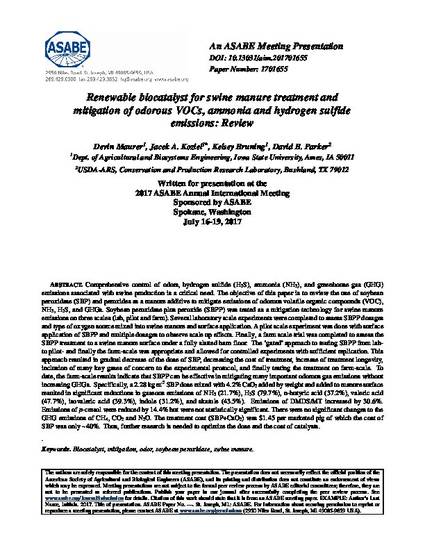
Comprehensive control of odors, hydrogen sulfide (H2S), ammonia (NH3), and greenhouse gas (GHG) emissions associated with swine production is a critical need. The objective of this paper is to review the use of soybean peroxidase (SBP) and peroxides as a manure additive to mitigate emissions of odorous volatile organic compounds (VOC), NH3, H2S, and GHGs. Soybean peroxidase plus peroxide (SBPP) was tested as a mitigation technology for swine manure emissions on three scales (lab, pilot and farm). Several laboratory scale experiments were completed to assess SBPP dosages and type of oxygen source mixed into swine manure and surface application. A pilot scale experiment was done with surface application of SBPP and multiple dosages to observe scale up effects. Finally, a farm scale trial was completed to assess the SBPP treatment to a swine manure surface under a fully slatted barn floor. The ‘gated‘ approach to testing SBPP from lab- to pilot- and finally the farm-scale was appropriate and allowed for controlled experiments with sufficient replication. This approach resulted in gradual decrease of the dose of SBP, decreasing the cost of treatment, increase of treatment longevity, inclusion of many key gases of concern to the experimental protocol, and finally testing the treatment on farm-scale. To date, the farm-scale results indicate that SBPP can be effective in mitigating many important odorous gas emissions without increasing GHGs. Specifically, a 2.28 kg m-2 SBP dose mixed with 4.2% CaO2 added by weight and added to manure surface resulted in significant reductions in gaseous emissions of NH3(21.7%), H2S (79.7%), n-butyric acid (37.2%), valeric acid (47.7%), isovaleric acid (39.3%), indole (31.2%), and skatole (43.5%). Emissions of DMDS/MT increased by 30.6%. Emissions of p-cresol were reduced by 14.4% but were not statistically significant. There were no significant changes to the GHG emissions of CH4, CO2 and N2O. The treatment cost (SBP+CaO2) was $1.45 per marketed pig of which the cost of SBP was only ~40%. Thus, further research is needed to optimize the dose and the cost of catalysts.
Available at: http://works.bepress.com/jacek_koziel/120/

This proceeding is from 2017 ASABE Annual International Meeting, Paper No. 1701655, pages 1-6 (doi: 10.13031/aim.201701655). St. Joseph, Mich.: ASABE.